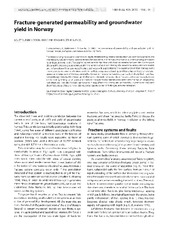Fracture-generated permeability and groundwater yield in Norway
Peer reviewed, Journal article
Published version
Permanent lenke
https://hdl.handle.net/1956/3581Utgivelsesdato
2002Metadata
Vis full innførselSamlinger
- Department of Earth Science [1034]
Sammendrag
The transport of groundwater in bedrock is largely determined by interconnected fractures and their apertures. The conditions by which fractures become interconnected are thus of primary importance in understanding permeability and groundwater yield. This applies in particular to the observed linear correlation between the current postglacial uplift rate and groundwater yield in the bedrock of southern Norway. We present boundary-element models on the formation of interconnected fracture pathways with application to the coastal areas of West Norway. In the models, we use external tensile stress and internal fluid overpressure; loading conditions that are likely to have been operative in large parts of Norway during the Holocene. The external tensile stress results indicate that many fracture pathways form by the linking up of offset joints through transverse shear fractures. Other pathways, however, are formed by linking up of joints and contacts through tensile stresses associated with the tips of propagating hydrofractures. How the fracture pathways form may affect the subsequent permeability. In particular, transverse shear fractures are likely to have relatively small apertures and limit the groundwater transport.
